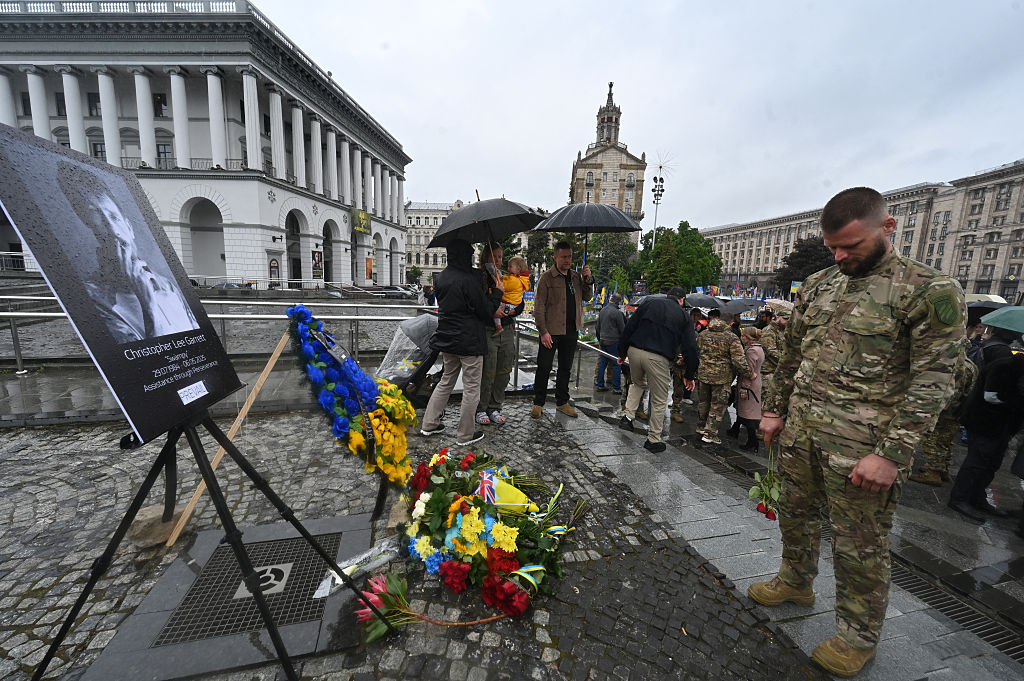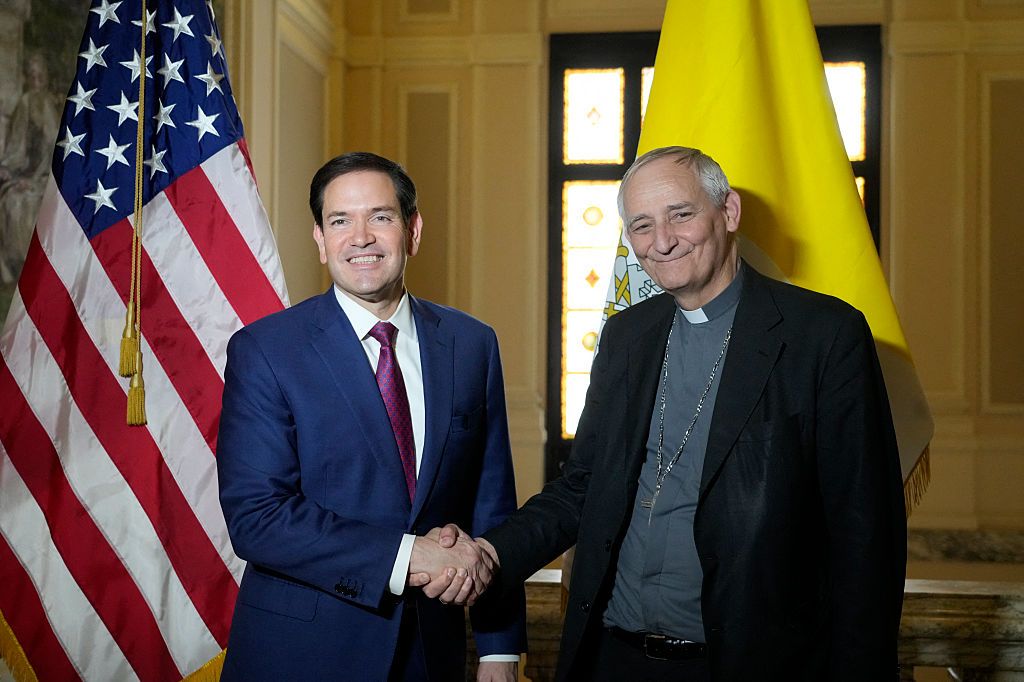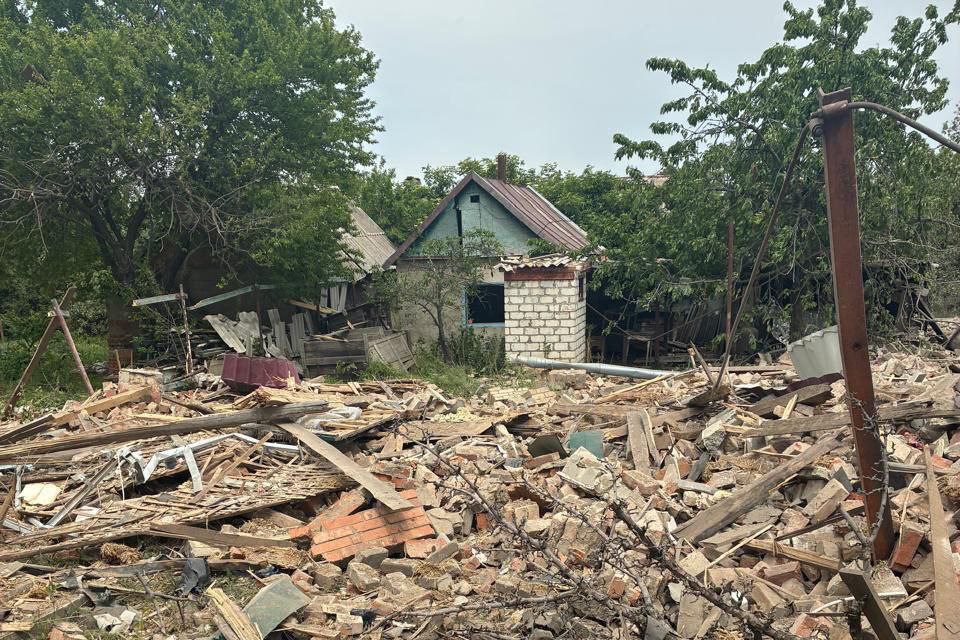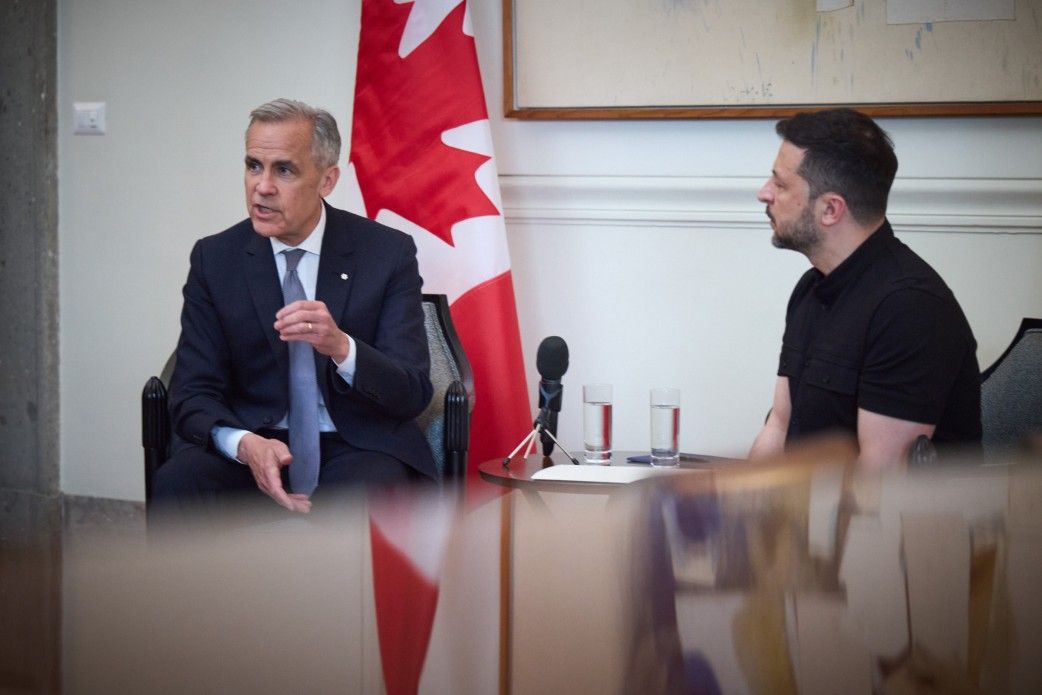As Russian demands escalate beyond Trump’s peace plan, a civilian bus in Sumy becomes the latest casualty of false hope, while preparations begin for history’s largest prisoner exchange
Summary of the Day – May 17, 2025
Hours after Russian negotiators departed Istanbul with their maximalist territorial demands firmly in place, a drone strike on a civilian evacuation bus in Bilopillia claimed nine lives—a grim reminder that Moscow’s concept of negotiations involves simultaneous bloodshed. The Kremlin formalized its Istanbul position, demanding Ukraine abandon not just territory but any hope of war reparations or foreign security guarantees, conditions that directly contradict Trump’s peace proposal. Yet amid the diplomatic wreckage, intelligence chief Kyrylo Budanov confirmed that the agreed prisoner exchange—1,000 souls from each side—could begin as early as next week. Meanwhile, Ukrainian forces advanced near Lyman as fighting intensified across multiple fronts, and Shahed drones revealed dangerous new capabilities that challenge air defense systems already strained by the war’s relentless pace.

A colleague reacts to the portrait of 40-year-old British volunteer and EOD technician Christopher Lee Garrett during a public memorial in honor of him at Independence Square in Kyiv on May 17, 2025. The Manx bomb disposal specialist who had been helping to train troops fighting in Ukraine has died after he was severely injured in an incident near Izium, in the east of Ukraine. (Photo by Sergei Supinsky / AFP via Getty Images)
Bilopillia’s Black Saturday: Nine Lives Lost in the Shadow of Peace Talks
The bitter irony was inescapable: as diplomats discussed ceasefires in air-conditioned palaces, death arrived at dawn on the potholed roads of Sumy Oblast. At precisely 6:17 a.m. on May 17, a Russian drone struck a civilian shuttle bus carrying evacuees near Bilopillia, killing nine people and injuring seven more in what local officials called “a black Saturday” in the city’s history.
The victims weren’t combatants or military targets—they were civilians seeking safety, transported in a clearly marked civilian vehicle along a recognized evacuation route. Among the dead was an entire family: father, mother, and daughter eliminated in a single strike that demonstrated Russia’s calculated disregard for the most basic humanitarian principles.
“This bus was carrying people out of the city for evacuation,” Bilopillia head Yurii Zarko told Ukrainian media, his voice heavy with grief. “Most of them are elderly women, along with two or three men.” The wounded were rushed to hospitals in Sumy, their bodies bearing burns, fractures, and concussions from an attack that could only be described as deliberate.
President Zelensky’s response captured the moral clarity that diplomacy often obscures: “The Russians could not have failed to know what kind of vehicle they were targeting. This was a deliberate killing of civilians.” The attack occurred less than 24 hours after Russian negotiators had walked away from Istanbul, having rejected any meaningful progress toward peace.
Three days of mourning were declared in Bilopillia—a small town learning once again that Russia’s version of negotiations includes the systematic targeting of those seeking only to survive.
The Kremlin’s Maximalist Manifesto: Putin’s Real Peace Plan Revealed
While the world parsed the diplomatic language emerging from Istanbul, Moscow was busy clarifying exactly what it meant by “peace negotiations.” Through a series of statements on May 17, Russian officials confirmed that their demands weren’t opening positions in a negotiation—they were ultimatums designed to secure Ukrainian surrender.
Kremlin spokesperson Dmitry Peskov made clear that Russia’s demands from Istanbul would serve as “preconditions” for any ceasefire, effectively reversing the normal sequence of conflict resolution. Instead of ending the killing first and then negotiating terms, Russia insisted on receiving territorial concessions before agreeing to stop the violence.
The demands revealed in their full scope represented a complete rejection of Trump’s proposed peace framework. While the U.S. had reportedly offered Russia “de facto” recognition of its control over currently occupied territories and “de jure” recognition of Crimea’s annexation, Moscow wanted far more: complete Ukrainian withdrawal from four entire oblasts, abandonment of NATO aspirations, neutrality status, foreign troop restrictions, and surrender of all war reparations claims.
Perhaps most tellingly, Peskov emphasized that identifying Ukraine’s authorized signatory remained “fundamental” for Russia—a clear signal that Moscow questions the legitimacy of any post-2014 Ukrainian government. This position doesn’t just reject Zelensky personally; it challenges the entire constitutional order that emerged after Ukraine’s democratic revolution.
Russian sources speaking to the opposition outlet Verstka were even more candid: Putin and Zelensky meeting was “out of the question” because Moscow knew its conditions were “non-starters” for Kyiv. The talks, they revealed, were theater designed to demonstrate Russian strength rather than pathways to peace.
The Promise of Exchange: 1,000 Souls, One Human Victory
Amid the diplomatic carnage, one flickering flame of hope burned brighter on May 17. Ukraine’s military intelligence chief Kyrylo Budanov confirmed that the prisoner exchange agreed in Istanbul—1,000 Ukrainian soldiers for 1,000 Russian captives—could take place as early as the following week.
“I hope it will happen next week,” Budanov told Ukrainian media. “I don’t see any major obstacles to this.” His words carried particular weight given the typically cautious nature of intelligence pronouncements and the complexity involved in arranging such exchanges.
The logistics alone stagger the imagination: compiling verified lists of 2,000 individuals, coordinating medical preparations for returned personnel, establishing secure exchange locations, and managing the emotional complexity of families waiting for loved ones who may or may not be on the final rolls.
Ukraine’s Security Service began immediate preparations, establishing infrastructure for receiving soldiers who had endured months or years in Russian captivity. Medical teams prepared to address not just physical wounds but the psychological trauma that inevitably accompanies prolonged detention in hostile conditions.
If completed, this exchange would dwarf all previous swaps in scale and potentially demonstrate that cooperation remains possible even when broader diplomatic efforts collapse. For the families involved, it represents hope in its purest form—the possibility that someone lost to war’s darkness might yet return to light.
Medvedev’s Nuclear Shadow: Escalation as Diplomatic Strategy
As if to underscore Russia’s commitment to intimidation over negotiation, Deputy Security Council Chairman Dmitry Medvedev issued a barely veiled nuclear threat on May 17. Writing on his English-language social media account, he warned that unsuccessful negotiations could lead to “a more terrible stage of war with new weapons and participants.”
The threat wasn’t subtle: Russia possessed nuclear weapons, allied forces, and the willingness to use both if its demands weren’t met. Medvedev’s statement represented classic “reflexive control”—the Russian strategic concept of manipulating opponents’ decision-making through carefully calibrated threats and promises.
His timing was precise, coming exactly one day after Istanbul talks had failed. The message was clear: compromise with Russia or face escalation beyond anything previously imagined. That such threats emerged from the same government supposedly engaged in “peace negotiations” revealed the fundamental cynicism underlying Moscow’s diplomatic approach.
Western intelligence agencies dismissed the immediate nuclear threat while acknowledging Russia’s pattern of using such rhetoric to extract concessions. Yet Medvedev’s words highlighted a disturbing truth: Russia viewed unsuccessful negotiations not as a reason to try harder for peace, but as justification for increased violence.
Ukrainian Advances: Progress Amidst Diplomatic Setbacks
While diplomats exchanged ultimatums and threats, Ukrainian forces demonstrated that military initiative hadn’t been abandoned to political calculation. Geolocated footage confirmed Ukrainian advances in central Torske, east of Lyman—proof that battlefield momentum could shift regardless of negotiating table dynamics.
The advance near Lyman came amid intensified Russian offensive operations across multiple directions. Russian forces had increased assault frequency in the Chasiv Yar area from three-to-five daily attacks to seven-to-nine, while maintaining pressure around Toretsk and Pokrovsk.
Lieutenant Colonel Dmytro Zaporozhets of Ukraine’s Luhansk Group of Forces reported that Russian commanders in the Toretsk direction had suffered approximately 50,000 casualties over ten months of fighting for the city, including roughly 20,000 killed. Yet Russian forces maintained sufficient personnel reserves to sustain their offensive pace.
The tactical picture revealed Russia’s strategic approach: accept massive casualties to achieve incremental gains, betting that time and attrition would eventually break Ukrainian resistance. Ukrainian forces responded with careful defensive operations designed to maximize Russian losses while preserving their own strength for future counteroffensives.
The Shadow Fleet’s New Target: Baltic Sabotage and Energy Warfare
Beyond the immediate battlefield, May 17 brought revelations about Russia’s expanding hybrid warfare campaign. German Foreign Minister Johann Wadephul announced enhanced surveillance and additional sanctions targeting Russia’s “shadow fleet,” following suspected sabotage of underwater infrastructure in the Baltic Sea.
“The threat has intensified over recent months,” Wadephul told Die Zeit, referencing severed cables, disrupted signals, and suspicious vessels operating throughout the region. While some incidents might have been accidental, the pattern suggested deliberate attempts to undermine European infrastructure.
The shadow fleet—aging tankers and cargo vessels operating under obscure ownership—served dual purposes: circumventing energy sanctions and potentially conducting sabotage operations. Wadephul called it “a direct security threat” requiring immediate European response through increased patrols and expanded sanctions.
The Baltic Sea campaign represented Russia’s strategy of maintaining pressure on Europe through means short of direct military confrontation. By threatening underwater cables and energy infrastructure, Moscow could impose costs on European societies while maintaining plausible deniability about its intentions.
Shahed Evolution: Flying Death Machines Get Deadlier
Ukrainian air defense specialists revealed on May 17 that Russian Shahed drones had undergone significant technical improvements, making them far more dangerous than the relatively primitive weapons that first appeared in 2022. The evolution reflected Russia’s commitment to perfecting its most cost-effective deep-strike weapon.
Speed had nearly doubled from 200 to 400 kilometers per hour thanks to jet engines replacing two-stroke piston motors. Payload capacity had tripled from 30 to 90 kilograms, while operational ceiling increased to 2,000 meters—beyond the effective range of many defensive systems.
More concerning was evidence of real-time control capabilities. Some Shaheds now flew with Starlink terminals, allowing Russian operators to adjust flight paths mid-mission based on live video feeds. This eliminated the predictable flight patterns that had previously made Shaheds relatively easy to intercept.
The improvements forced Ukrainian air defense to adapt constantly. Mobile teams reported engagement windows shrinking to five or six seconds for low-flying drones, requiring split-second decisions about targeting and ammunition expenditure.
Trump’s Monday Morning Call: Putin on the Line
President Trump announced via Truth Social that he would speak with Putin by telephone on Monday, May 20, at 10 a.m.—a conversation potentially more consequential than all the Istanbul negotiations combined. Trump framed the call’s purpose as “stopping the ‘bloodbath’ that is killing, on average, more than 5,000 Russian and Ukrainian soldiers a week.”
The announcement came as European leaders expressed growing frustration with Trump’s shifting positions on Ukraine policy. After initially supporting European calls for an unconditional ceasefire, Trump had begun emphasizing direct engagement with Putin as the key to any breakthrough.
“I will then be speaking to President Zelensky of Ukraine and then, with President Zelensky, various members of NATO,” Trump added, outlining a sequence suggesting he viewed himself as the crucial intermediary between the warring parties.
Kremlin spokesperson Peskov confirmed preparations for the call were underway, while Russian Foreign Minister Lavrov had already spoken with Secretary of State Rubio about bilateral relations and the Istanbul talks’ aftermath.
Military Command in Crisis: A Battalion Commander’s Revolt
The day’s tensions extended beyond international diplomacy to Ukraine’s internal military dynamics. Oleksandr Shyrshyn, battalion commander of the 47th Separate Mechanized Brigade, submitted his resignation with a scathing public denunciation of military leadership.
“I have never received more stupid objectives than in the current direction,” Shyrshyn wrote on Facebook, accusing commanders of “senseless orders” and “unnecessary casualties.” His brigade, trained by NATO and equipped with advanced Western weaponry, had been among Ukraine’s most capable formations.
Shyrshyn’s complaint reflected broader tensions within Ukraine’s military structure, where frontline commanders increasingly questioned strategic decisions made by senior officers with limited recent combat experience. The resignation of such a prominent battlefield leader represented a significant internal challenge for Ukraine’s defense establishment.
“I hope your children will also serve in the infantry and carry out your orders,” Shyrshyn added—a bitter comment suggesting that those making tactical decisions were insulated from their human consequences.
Vatican Diplomacy: The Pope’s Peace Proposal
Adding a spiritual dimension to the week’s diplomatic efforts, Secretary of State Marco Rubio confirmed that the Vatican could serve as a venue for future peace talks. Speaking to reporters in Rome, Rubio described the Holy See as “a place that both sides would be comfortable going.”

Secretary of State Marco Rubio (L) and President of the Conference of Italian Bishops, Cardinal Matteo Zuppi, pose for a photo at the U.S. Embassy to the Holy See in Rome. (Gregorio Borgia / POOL / AFP via Getty Images)
Pope Leo XIV, the first American pontiff, had pledged to “make every effort so that this peace may prevail.” Cardinal Pietro Parolin emphasized the Vatican’s readiness to host direct negotiations, calling the talks “tragic” but expressing hope that leaders would eventually “talk.”
The Vatican’s involvement reflected growing international frustration with traditional diplomatic channels’ ineffectiveness. As the first American pope, Leo XIV brought a unique perspective to the conflict while maintaining the Holy See’s traditional role as neutral mediator.
The papal offer represented one of several alternative diplomatic venues being explored as conventional state-to-state negotiations appeared increasingly futile.
The Arithmetic of Attrition: 50,000 Russian Casualties for Toretsk
The human cost of Russia’s tactical advances became starkly clear through Ukrainian military reporting. Lieutenant Colonel Dmytro Zaporozhets revealed that Russian forces had suffered approximately 50,000 casualties—including roughly 20,000 killed—during ten months of fighting for Toretsk alone.
This staggering toll for a single contested town illustrated the mathematics of Russia’s strategy: accept massive losses to achieve incremental gains, betting that sustained pressure would eventually break Ukrainian resistance. Despite the enormous casualties, Russian commanders maintained sufficient personnel reserves to increase assault frequency from three-to-five daily attacks to seven-to-nine.
The casualty figures provided context for recent Russian advances around Toretsk, where geolocated footage confirmed the capture of Oleksandropil and Nova Poltavka. Each tactical victory came at a price measured in thousands of lives—a calculus that Russian leadership appeared willing to sustain indefinitely.
Additional advances were confirmed near other frontline cities: Bahatyr west of Kurakhove, positions in Chasiv Yar’s center, and incremental gains around Pokrovsk and Novopavlivka. The cumulative effect was a slowly shifting map purchased with an ocean of blood.
Donetsk Under Fire: Death Comes to Yablunivka
The killing in Sumy Oblast wasn’t an isolated incident. Russian forces launched multiple attacks across Donetsk Oblast throughout May 17, killing one person and injuring eight more in what had become the war’s bloodiest continuous battleground.

The aftermath of Russia’s drone strike in Donetsk Oblast. (Donetsk Regional Military Administration via Telegram)
A 27-year-old woman died when a Russian FPV drone struck Yablunivka settlement in the morning. The attack demonstrated Russia’s increasing use of small, precise drones to target individual civilians—a tactic that blurred the lines between military operations and terrorism.
Additional Russian drone strikes hit a civilian car in Andriivka, injuring five people including one minor. Two more civilians were wounded in Pokrovsk and Myrnohrad, continuing the daily toll that had made life in frontline areas increasingly untenable for remaining residents.
Governor Vadym Filashkin’s dry accounting—”18 towns and villages” hit by Russian shelling across Donetsk Oblast—captured the systematic nature of attacks designed to make civilian life impossible in areas Ukraine still controlled.
In a stark reminder of Russia’s contempt for international law, a Russian-installed court in occupied Luhansk Oblast sentenced Australian national Oscar Jenkins to 13 years in a high-security penal colony on charges of serving as a “mercenary” against Russian forces.
Jenkins, a biomedical sciences graduate with no prior military experience, had volunteered to serve in Ukraine’s 402nd Separate Rifle Battalion after traveling from Melbourne in early 2024. He was captured near Mykolaivka in December 2024 while serving with Ukraine’s 66th Separate Mechanized Brigade.
Australian Foreign Minister Penny Wong condemned the “sham trial,” emphasizing that Jenkins should be treated as a prisoner of war under international humanitarian law. Australia has been pressing for his release since his capture, with officials maintaining that Russia’s refusal to recognize his POW status violates established legal norms.
The sentencing occurred in a court system not recognized internationally, operated by authorities under Moscow’s control. Jenkins’ case illustrated Russia’s broader strategy of using captured foreign volunteers as propaganda tools while denying them basic legal protections guaranteed under the Geneva Conventions.
Fire in Crimea: SBU Strikes Deep into Occupied Territory
Ukrainian intelligence operations continued to demonstrate their capability to strike deep into Russian-occupied territory. A security source confirmed to Ukrainian media that Security Service drones had successfully attacked an ammunition depot used by Russia’s 126th Coastal Defense Brigade near Perevalne in occupied Crimea.
The depot, located near the strategic highway connecting Simferopol and Alushta, housed military equipment, ammunition, and fuel storage facilities. Local residents reported thick smoke rising from the military compound as explosions echoed across the area, forcing Russian authorities to block traffic along the vital transportation route.
“The Security Service of Ukraine continues to effectively strike legitimate military targets in Russian-occupied Crimea,” the source said. “Efforts to degrade [Russia’s] military capabilities will continue.” Reports suggested the strike had caused significant damage and potentially killed Russian military personnel, though Moscow had not officially commented on the incident.
These deep-strike operations reflected Ukraine’s growing capacity to project power far beyond the front lines, complicating Russian logistics and demonstrating that occupied territories remained vulnerable to Ukrainian retaliation. The attack forced Russian authorities to block traffic along the strategic Simferopol-Alushta highway, disrupting civilian and military transportation across the peninsula.
European Solidarity: Canada’s Carney Reaffirms Commitment
In Rome, where world leaders gathered for Pope Leo XIV’s inaugural Mass, Canadian Prime Minister Mark Carney met with President Zelensky to reaffirm his country’s “steadfast and unwavering support” for Ukraine. The encounter marked their first face-to-face meeting and occurred against the backdrop of growing international frustration with Russia’s negotiating positions.

Canadian Prime Minister Mark Carney and President Volodymyr Zelensky meet in Rome. (Office of the President of Ukraine)
“We admire what you are doing. We admire your commitment to peace, which you have demonstrated again this week,” Carney told Zelensky, referencing Ukraine’s constructive approach during the failed Istanbul talks. “Let me underscore that there can be no peace without the full support and participation of Ukraine—and you have our absolute support.”
The meeting focused on sanctions strategies, including secondary measures targeting Russia’s shadow fleet and energy sector. Carney confirmed Zelensky’s invitation to the G7 Summit in June, which Canada will host as current president, while Zelensky extended a reciprocal invitation for the Prime Minister to visit Ukraine.
Their discussion underscored the continuing Western commitment to Ukraine despite diplomatic setbacks and reflected concerns about maintaining alliance unity as the conflict entered its fourth year.
Sanctions Tighten: EU’s 17th Package Targets Shadow Fleet
European Union ambassadors finalized agreement on the bloc’s 17th sanctions package against Russia, primarily targeting the shadow fleet of oil tankers that enables Moscow to circumvent energy restrictions. The package represented incremental progress in economic warfare, though critics argued it fell short of the comprehensive measures required to meaningfully impact Russia’s war economy.
The sanctions would formally target additional vessels involved in transporting Russian oil, expand restrictions on maritime insurance, and potentially include measures affecting the Nord Stream pipeline system. European Commission President Ursula von der Leyen welcomed the agreement, insisting it would “keep the pressure high on the Kremlin.”
Behind closed doors, however, EU officials acknowledged the package had been “watered down” during negotiations, reflecting continued disagreements among member states about the appropriate level of economic pressure on Russia. The measures would be formally adopted on May 20 during a foreign ministers’ meeting in Brussels.
The shadow fleet sanctions highlighted the ongoing cat-and-mouse game between European regulators and Russian sanctions evasion networks, with Moscow consistently finding new ways to circumvent restrictions through third-party countries and shell companies.
Belarus Offers Mediation: Lukashenko’s Diplomatic Gambit
Belarus offered to facilitate peace negotiations between Ukraine and Russia, with President Alexander Lukashenko’s spokesperson emphasizing that while Minsk wouldn’t seek to mediate directly, it remained ready to “organize the peace process if all sides agree.”
The offer carried obvious credibility problems: Belarus had served as a launching pad for Russia’s initial invasion in February 2022 and had recently ratified a security treaty deepening military cooperation with Moscow. Belarusian forces had been trained by Russian instructors and equipped with Russian weapons, making any claim to neutrality highly questionable.
Nevertheless, the proposal reflected growing international recognition that traditional diplomatic channels had proven inadequate for achieving breakthrough between the warring parties. With Turkey hosting failed talks and the Vatican offering future mediation, multiple countries were positioning themselves as potential peace brokers.
The Belarusian offer also served Lukashenko’s domestic and international interests, allowing him to present himself as a peace-seeking leader rather than merely Putin’s subordinate—even as his country remained firmly within Russia’s sphere of influence.
